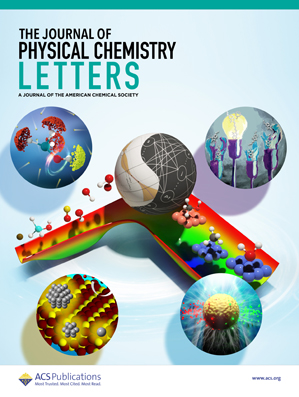(Photo)redox Processes Involving the Eu(II)/Eu(III) Couple.
IF 4.8
2区 化学
Q2 CHEMISTRY, PHYSICAL
引用次数: 0
Abstract
Processes involving electron transfer driven by differences in chemical potential and/or light hold promise for chemical transformation. One system that has been proposed for these applications is the versatile Eu(II)/Eu(III) redox couple, where either species has diverse and tunable optical and electrochemical properties. Here, the details of the processes involved in electron transfer from and to europium centers are considered and probed using seven differing organic dyes in dimethyl sulfoxide (DSMO)─the only solvent where all species are soluble and can be oxidized and reduced. Most dyes were reduced by Eu(II), but one dye, triazatriangulenium (TATA), enabled an experimental determination of quenching by Eu(III) and Eu(II) via photoelectron transfer quenching. It was found that while Eu(III) does not interact strongly with the organic dyes, Eu(II) is a potent reducing agent for organic molecules, disregarding whether the substrate is in the ground state or the excited state. We concluded that ground state reduction of any substrate by Eu(II) must be considered in all cases, where photoredox chemistry involving the Eu(II)/Eu(III) redox couple is explored. Finally, we advocate that the redox potentials of all involved species be determined if a mechanism is proposed.(图)涉及Eu(II)/Eu(III)偶联的氧化还原过程。
由化学势和/或光的差异驱动的电子转移过程有望实现化学转化。针对这些应用提出的一种系统是通用的Eu(II)/Eu(III)氧化还原偶联,其中任何一种都具有多样化和可调谐的光学和电化学性能。本文使用七种不同的有机染料,在二甲亚砜(DSMO)中研究了电子从铕中心转移到铕中心的过程的细节,DSMO是唯一一种所有物质都可溶解并能被氧化和还原的溶剂。大多数染料被Eu(II)还原,但有一种染料,三氮三棱(TATA),可以通过光电子转移猝灭的方式测定Eu(III)和Eu(II)的猝灭作用。研究发现,尽管Eu(III)与有机染料的相互作用不强,但无论底物处于基态还是激发态,Eu(II)都是有机分子的强还原剂。我们的结论是,在所有情况下都必须考虑Eu(II)对任何底物的基态还原,其中涉及Eu(II)/Eu(III)氧化还原对的光氧化还原化学进行了探索。最后,我们主张,如果提出一个机制,所有涉及的物种的氧化还原电位被确定。
本文章由计算机程序翻译,如有差异,请以英文原文为准。
求助全文
约1分钟内获得全文
求助全文
来源期刊

The Journal of Physical Chemistry Letters
CHEMISTRY, PHYSICAL-NANOSCIENCE & NANOTECHNOLOGY
CiteScore
9.60
自引率
7.00%
发文量
1519
审稿时长
1.6 months
期刊介绍:
The Journal of Physical Chemistry (JPC) Letters is devoted to reporting new and original experimental and theoretical basic research of interest to physical chemists, biophysical chemists, chemical physicists, physicists, material scientists, and engineers. An important criterion for acceptance is that the paper reports a significant scientific advance and/or physical insight such that rapid publication is essential. Two issues of JPC Letters are published each month.
 求助内容:
求助内容: 应助结果提醒方式:
应助结果提醒方式:


